
Venice entry fee will start next year
After talking about an entrance fee for several years, the Venetian authorities have now confirmed that a pilot project charging day-trippers will begin in spring 2024. Visitors will pay 5 euros to enter the city on busy days.
2023-09-06 21:47
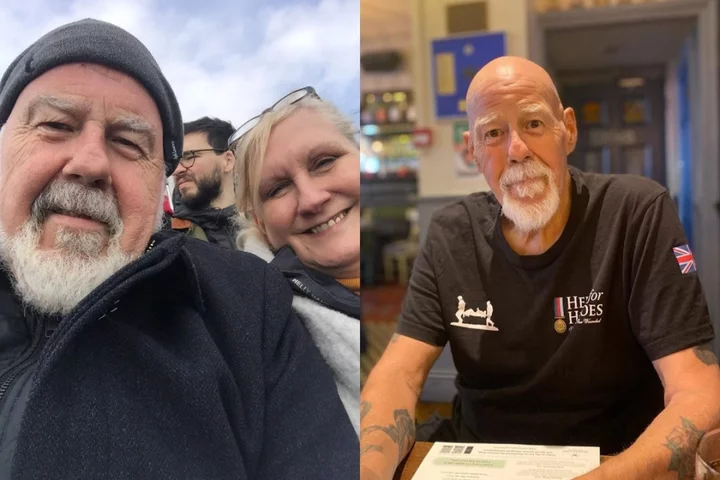
Cancer-hit dad who planned his own funeral defies doctors’ three-week life expectancy prognosis
A father-of-three who was told he looked like “Casper the ghost” before being diagnosed with acute myeloid leukaemia (AML) and given three weeks to live, meaning he has planned his own Requiem Mass and funeral, has defied doctors’ expectations by outliving his prognosis by more than a year and said he is going to “keep fighting”. Dennis Blackman, 62, a former chartered building surveyor and carer who lives in Eltham, London, said he has always been active – playing rugby, lifting weights, and going to the gym at least three times a week. However this all changed when he suffered an unexpected stroke in 2015. His health deteriorated over the following years, he had a hip replacement at 58, and after experiencing symptoms of extreme exhaustion, cold hands, and muscle weakness in early 2022, his wife Sally, 62, a former flooring showroom manager, suggested he book a doctor’s appointment. After weeks of blood tests and blood transfusions in hospital and being told he looked like “Casper the ghost” because he was so pale, he underwent a bone marrow biopsy, and this led to the devastating news in March 2022 that he has AML – a type of blood cancer – and three weeks to live. Dennis told PA Real Life: “I just broke down and I had this unbelievable feeling of guilt because I said to the consultant: ‘What have I done wrong? How do I tell my children and wife?’ “It’s a huge burden to put on someone, to tell them that you’re dying and it’s going to be very quick. “We had many dark days, and every time I looked into my children’s eyes I just burst into tears… it was a very emotional period for all of us.” Dennis, who has lost 50kg (7st 9lbs) since his diagnosis, did not start chemotherapy until months later due to him being too weak, and in January 2023, he was told the chemotherapy was “not working any more”. From that point on, he said he wanted to “enjoy each day” rather than pursuing more aggressive forms of treatment – and since then, he has planned his own Requiem Mass with hymns such as How Great Thou Art and Ave Maria (As I Kneel Before You), as well as the arrangements for his funeral. Now, Dennis continues to drive, go shopping, and enjoy time with his family, and he said he is going to “keep fighting” during the time he has left as “you only have one life”. “Every day you go to bed and you think: ‘Am I going to wake up tomorrow?’ And then each morning you think: ‘Is it going to be today that I’m going to die?’” Dennis explained. “It was extremely difficult in the beginning and I tried to shut the world out… but as time went on, I realised you can’t live like this forever. “You only get one life, so I’m going to do everything I can to keep fighting.” During his 40s and early 50s, Dennis said he enjoyed going out for meals with his wife Sally, playing rugby with his sons James, 37, and Joe, 31, and keeping fit by going to the gym several times a week. He foresaw spending his days in retirement with his family, out in the garden, or fishing, but he said this all changed when he had a stroke in 2015, aged 54, and his health declined from then on. In early 2022, he spent six weeks at Queen Elizabeth Hospital in London after noticing some unusual symptoms and was told: “You look like Casper (the ghost), you’re very anaemic.” He then underwent several blood tests and blood transfusions, and although he had “an idea” that he may have cancer, he said he could never have prepared himself for his diagnosis on March 31 2022. “About one o’clock, I had a knock at the door and I thought: ‘That’s ominous’,” Dennis said. “The consultant and the specialist nurse came in and they said: ‘Unfortunately it’s bad news, you’ve got severe AML and there’s not a lot we can do at this stage.’ “’You’ve got three weeks to live, and I’d advise you to go home and tell your wife and family, and make sure everything’s in order because you haven’t got long left’.” Given Dennis has severe neutropenia as well – a low number of white blood cells – he is at a higher risk of contracting serious infections, and this meant he missed several family celebrations in the months that followed, including his grandson’s birthday party and stepdaughter’s wedding. He developed multiple chest infections and fevers and was not deemed fit enough to start chemotherapy straight away, and he ended up spending three months in hospital from July to October. “We thought we were going to lose him, he was so ill,” Sally, who has been married to Dennis for 10 years, explained. “Even the consultant thought we were going to lose him. “I was scared because I just thought: ‘How can this be happening when we’ve only just met each other?’ We just thought we were going to have the rest of our lives together.” However, Dennis, who is Catholic, said he “fought and prayed every day”, adding: “I said to the consultant: ‘If you promise to me you won’t give up on me medically, I promise I’ll fight this all the way.’” Dennis was determined to get better and, with the help of a physiotherapist, he built up his strength – and at one point, he was walking 10,000 steps a day along the hospital corridor. Towards the end of October 2022, Dennis said “everything seemed hunky dory” and he commenced the first of four rounds of chemotherapy, where he experienced nausea, exhaustion, and “tremendous leg bone pain”. By January, he was told the chemotherapy was “not working”, but rather than trying other forms of treatment, he said he wanted to “enjoy the little things” and the time he has left. He has planned his own Requiem Mass and funeral to relieve any pressure from his family, but also to give him “strength” and some control over his destiny – and aside from his regular check-ups and blood tests each week, he is setting himself small milestones, such as attending a Madness concert at the O2 in December. Although he is “struggling to survive”, he said he would do “anything to get another day” – and that is why he is holding onto hope and wants to encourage others never to give up. “Even though I pray every day, not once have I asked God to take it away from me – all I ask is that He’s with me when I need him, to give me the strength to carry on fighting,” he said. “Leukaemia is painful and every day I question whether I’ll see another day, but we just try and keep going and I hope that my story gives hope to others. “I’ve still got lots of memories to make yet, so I’m going to fight this all the way.” For more information and support, visit Leukaemia Care’s website at leukaemiacare.org.uk Read More Charity boss speaks out over ‘traumatic’ encounter with royal aide Ukraine war’s heaviest fight rages in east - follow live One in 10 ‘spending beyond their means’ – try these 7 cutbacks guaranteed to save families money What is combination cholesterol therapy, as study suggests it could save lives? Cancer cases in young people ‘are rising’ – the warning signs to look out for
2023-09-06 21:21

Upgrade Your Easter With This LEGO Egg Decorating Machin
Cut your egg decorating time in half with this fun LEGO project.
2023-09-06 18:53

Stranger Things Fan Puts Up Fake Jim Hopper Campaign Signs in New York
One 'Stranger Things' fan decided to turn the election season Upside Down by adding their own candidate to the ballot.
2023-09-06 18:27

Is bottomless prosecco going to be killed off by climate change?
Picture this. The group chat has finally settled on a date and we are going out. Out out. Women of most ages know how serious this is. There was probably a spreadsheet involved. Boyfriends and husbands have been dispatched to the pub. Children and dogs have been dropped off at the sitter. Dignity has been left at the door. One of us is waiting for it to be cancelled so we can stay at home with our loungewear and girl dinners (it’s probably me). There’s only one thing for it. Bottomless brunch. Many Asos orders and outfit changes later, we arrive, take our seats and start the binge drinking timer. There’s only one problem. No prosecco. Freshly manicured fists pound the table. The elected Karen of the group starts to verbally pulverise the staff. Eggs Benedicts are thrown against the walls. The Prosecco Huns exclaim in unison: “But what are we going to drink now?!” The waiter bashfully suggests: “Spumante?” Give over. According to a new study, this could be a reality in the near future thanks to climate change threatening vineyards across Europe, in particular those dedicated to glera (the beloved prosecco grape) in Northern Italy. In a detailed report in iScience last month, researchers warned that unpredictable weather, soil degradation and drought could lead to the loss of a millennia-old winemaking tradition, and the livelihoods attached to it. RIP the Prosecco Hun. The Italian sparkling wine has long been the fizz of choice in the UK (we were only dethroned as the world’s biggest prosecco guzzlers last year by the US). In the early 2010s, more than a third of all the prosecco shipped out of Italy worldwide ended up in Britain – approximately 131 million bottles a year. That’s nearly two bottles per Brit. You get the idea. The origin of our obsession with prosecco dates back to just after the 2008 crash, when consumers were looking for an alternative to expensive champagne. The softer tasting, far more affordable (thanks to its cheaper and speedier production time) and incredibly quaffable prosecco was the obvious choice. Bottomless brunch was born. “My heart goes out to the huns whose weekends simply aren’t complete without a bottle of prosecco,” Hannah Crosbie, founder of Dalston Wine Club, laments at the news that just 15 years after it stormed onto supermarket shelves, prosecco might be quietly forced to say arrivederci. “In all seriousness though, climate change is seriously threatening every aspect of winemaking, and growing conditions are only getting more challenging.” Prosecco is certainly not the only vino at risk, but it faces a unique issue. Where other wine growing regions affected by climate change such as Champagne and Burgundy can simply put out a limited run with an inflated price tag and keep the snobby oenophiles coming, prosecco’s USP is its ability to produce in bulk and at a fraction of the cost. English sparkling is a big winner with the climate going the way it is. Prosecco, by all accounts, seems like it’s a bit of a loser in that regard Will Amherst, head wine buyer at Trullo Ali Finch, group sommelier at Angela Hartnett’s Michelin-starred Italian restaurant Murano in Mayfair, doesn’t believe there’s an appetite for a higher quality, more expensive prosecco. “With the impact of the climate as well as the cost of producing wine increasing, the challenge for prosecco is going to be how to balance the expectation of its price point with the need to make slightly smaller quantities,” she tells me. “Regions like Chablis, for instance, have had multiple horrible vintages back to back and people just accept the fact they have to pay more for it if they want to drink that wine.” For the uninitiated, the word “vintage” on a wine label simply means the year the grapes were harvested – compared to regular wines that may include grapes harvested in multiple years – and each vintage can taste vastly different based on the conditions affecting the grapes in that year. Chablis, produced from chardonnay grapes in the northernmost district of Burgundy, has always been particularly affected by the climate due to its geography, but in recent years has seen frost in 2016, 2017 and 2021, and drought and higher temperatures in 2019 and 2020. This has dramatically affected those vintages, and driven up the price of bottles from “good” years. But with prosecco, “people potentially wouldn’t be interested in” paying a higher price, Finch says. This is partly because its brand has become more associated with cheap fizz than fine wine in Britain. Part of the problem also lies in the simplicity of its production. Prosecco is a wine that reflects the aromatics of the grape at the point of harvest, whereas with other sparkling wines like champagne, as well as other types of wine in general, such as chablis, it’s about the ageing process. Rising temperatures mean grapes are ripening more quickly, which can result in a different flavour of wine or too much alcohol, so one option is to harvest the grapes earlier. You can get away with a slightly under-ripe fruit in aged wines as so much of the flavour is added during their long fermentations. In prosecco, a bottle of which is ready in just 30 days, an under-ripe grape could result in something that “tastes a lot like battery acid”, according to Finch. The Prosecco Huns don’t want to chug something flavourless and eye-wateringly alcoholic with their eggs Benedict. “If you pick too early, you’ve got no flavour,” Finch explains. “So they don’t really have the option to just keep making it in the same volume. With other wines, you can do more work in the winery to make the wine feel more balanced and more approachable and more complex. They don’t have that luxury in prosecco.” Under Italy’s DOC (Denominazione di Origine Controllata) laws, prosecco is only prosecco when it comes from just two regions of the country, Veneto and Friuli-Venezia Giulia, and adheres to strict growing and production rules. The same goes for champagne: only wine produced from eight permitted varieties of grape grown exclusively in the Champagne region of France may be called champagne. It’s these “heroic viticulture” sites that the report says are most at risk. Naming rights have been a point of contention across the whole wine industry for some time, with Australian producers of glera recently putting in a request to the EU to be allowed to call their wine prosecco on the grounds that it’s part of their migrant and cultural identity. Ironically, the glera grape is actually believed to be Slovenian in origin, and was first cultivated in the vineyards of Prosecco, a small village in the Friuli-Venezia Giulia region near the border with Slovenia. The name is even thought to derive from the Slovenian words preseka or poseka, or the Serbian/Croatian prosek, meaning “path cut through the woods”. While DOC laws might prevent anyone calling a sparkling wine made from glera grapes outside of the designated regions a prosecco, it hasn’t stopped winemakers around the world from essentially producing the same wine using the same techniques. As climate change has made it increasingly difficult to cultivate the grapes in their historical home, it’s also made conditions in more northern regions like the UK more favourable for the growing of certain grapes, including white varieties such as glera, opening the door to a whole new generation of winemakers. “This is not me saying this is the death of prosecco,” Finch adds quickly, but she stresses that the wine industry is naturally very dynamic. “There are loads of alternatives to prosecco, both within Europe in terms of pet nats and cremants and things like that, and with the New World as well.” Pet nats – sparkling wines made using the “traditional method” of fermenting in individual bottles – have become very trendy among the younger Gen Z crowd, she says, as it still offers something bright, fruity and super fizzy, but without the faff, or price tag, that comes with champagne. People are also drinking less but are happy to spend a little more and not drink as much. At Murano, Finch says diners are asking about English sparkling wines more than ever before. “The correlation, obviously, with post-Brexit is there. There’s a desire to try and drink more local wines, potentially from a sustainability point of view, potentially from a cost-to-quality point of view because of duty increasing. It’s also partly because during Covid people did a lot of staycations and UK wine tourism did very well during that time. And it sort of stuck.” It’s a sentiment echoed by Will Amherst, head wine buyer at Italian trattoria Trullo in Islington, north London. “I don’t want to bash prosecco too much, but if I was going out and I wanted sparkling wine, I would still look at champagne,” he says, much to the chagrin of the Prosecco Huns. “And if I’m going to look somewhere other than that, I would get a bottle of English sparkling. Because English sparkling is a big winner with the climate going the way it is. Prosecco, by all accounts, seems like it’s a bit of a loser in that regard.” Prosecco and the people that produce it are certainly not the only losers but its high-altitude, cooler temperature geography, which previously protected it from climate change, is now adversely affected by extreme weather. Sudden, intense rainfall damages the soil and creates “slope failures”, while conversely droughts make irrigation extremely difficult. While he’s yet to see a knock-on effect on prosecco supplies at Trullo, Amherst’s “immediate thoughts were, really sadly: is prosecco going to be able to pull itself out of that hole? I don’t know how you reconcile the spiralling production costs and the brand identity, which is synonymous with cheap wine in this country,” he says. Although it’s not recommended to keep prosecco longer than two to three years before it goes flat – compared to up to 10 years for vintage champagnes – he doesn’t anticipate stocks to run down soon. At any rate, his biggest use for prosecco at Trullo is in an Aperol Spritz, where it makes up half the drink. He actually sees it as an exciting opportunity for new wines to emerge. So does Will Hill, a wine buyer at online merchant Honest Grapes, who tells me: “Once again, cava is showing that there is great value to be found in traditional method sparkling wines and more and more we are seeing ‘prosecco-esque’ wines for lower prices. If the consumer isn’t tied to the name ‘prosecco’, there are plenty of good, affordable, entry-level options available.” It’s clear that wines of all colours are facing an uphill battle (quite literally in prosecco’s case), not just to survive but to protect their identity, which for prosecco is arguably more important. That could spell the end of the Prosecco Hun, but with English sparkling and other European varieties on the rise, perhaps it just means a rebranding is in order. Cremant Crew? Pet Nat Posse? They don’t have quite the same ring, but it won’t stop us booking bottomless brunch anytime soon. Read More I feel it in my fingers: Why more of us should start eating with our hands Pizza, cake and meringue martinis: When did cinema food get so silly? Michelin-starred chef Simon Rogan on 20 years of L’Enclume: ‘It all started with a radish’
2023-09-06 15:20
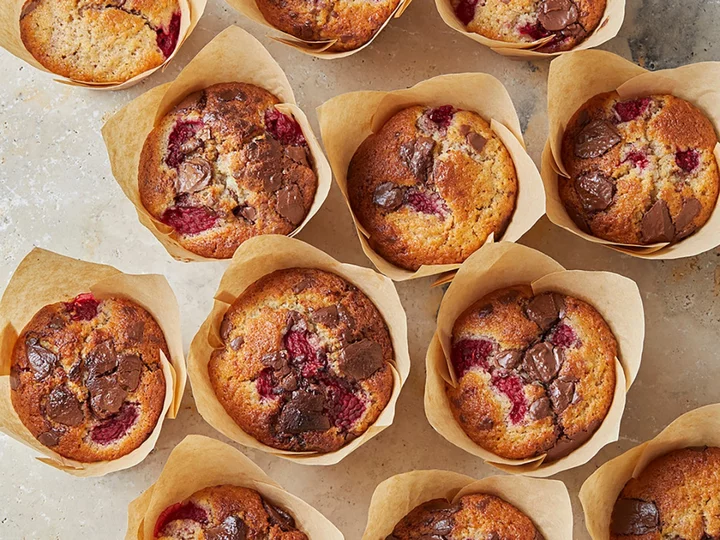
Thrifty and fruit coconut, raspberry and chocolate muffins
The combination here tastes wonderful whether you’re using fresh raspberries in season (when they’re cheaper) or frozen raspberries,” says former Great British Bake Off contestant Hermine Dossou. “To enhance the flavour of your desiccated coconut, you could toast it lightly (for five minutes or so) while preheating the oven – but keep an eye on it as it does turn brown very quickly.” Coconut, raspberry and chocolate muffins Makes: 12 Ingredients: 180g milk 2 large eggs 60g vegetable oil 60g unsalted butter, melted 230g sugar 1 tsp vanilla extract ½ tsp ground cinnamon ½ tsp ground nutmeg 5g salt 250g plain (all-purpose) flour (gf plus ½ tsp xanthan gum) 80g desiccated (dried shredded) coconut 10g baking powder (gf) 150g raspberries 150g milk chocolate, chopped into chunks Method: 1. Preheat the oven to 200C/180C fan/400F/gas 6 and line a 12-hole muffin tin with paper cases. 2. In a large mixing bowl, mix together the milk, eggs, oil, butter, sugar, vanilla, cinnamon, nutmeg and salt for about a minute, until well combined. Add the flour, coconut and baking powder and stir until fully incorporated. Fold in half the raspberries and all the chocolate chunks. 3. Divide the batter equally between the muffin cases. Top each muffin with a couple of the remaining raspberries. Bake for 25–30 minutes, or until the muffins have risen and are golden brown. You can keep these for a few days in an airtight container, or, once cooled, freeze them for up to 3 months. They are lovely served warm – either out the oven or reheated for a few seconds in the microwave. ‘The Thrifty Baker’ by Hermine Dossou (White Lion, £18.99).
2023-09-06 13:57
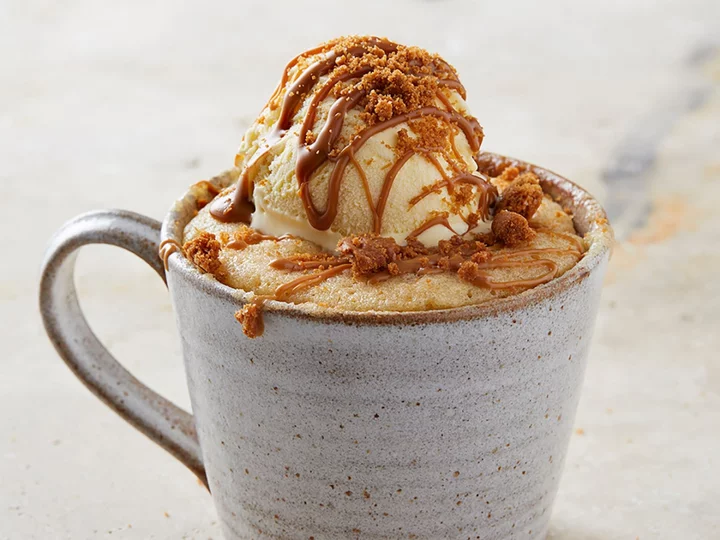
For a quick sugar fix, try this Biscoff microwave mug cake
Microwave cakes will never replace an oven-baked cake, in my opinion, because good things take time to create,” says former Great British Bake Off contestant, Hermine Dossou. “That said, when you don’t have an oven, when you’re not in your own kitchen with your own equipment, when you’re limited by time, or even have just a few bits of ingredients here and there, microwave mug cakes make a great substitute. And they’ll help you get rid of that sugar craving!” Speculoos mug cake Serves: 1 Ingredients: 30g salted butter 1 tsp speculoos spread 40g sugar 25g whole milk 1 small egg 40g self-raising flour 1 tsp vanilla extract For the topping: 1 tbsp speculoos spread 1 scoop vanilla ice cream 1 speculoos or other biscuit, for crumbling Method: 1. Put the butter and speculoos spread in a large mug and microwave on medium–high power (600 watts) for 10-20 seconds. Stir until smooth. 2. Add the sugar and milk and stir until combined. Then add the egg and mix vigorously with a whisk or small spatula to avoid streaks of egg white in your cake. 3. Finally, add the flour and vanilla, mixing thoroughly to ensure there are no lumps. 4. Microwave on medium–high (600 watts) for one minute. Keep an eye on the cake as each microwave cooks differently. You want the batter to be only just cooked; when you lightly touch the top, it should feel slightly sticky. If it feels completely dry, you have overcooked your cake. Remove from the microwave and allow to cool. 5. To serve, melt the one tablespoon of speculoos spread in the microwave for about 10 seconds. Top the cake with a scoop of vanilla ice cream, drizzle with the melted speculoos spread and sprinkle with the crumbled biscuit. Enjoy. ‘The Thrifty Baker’ by Hermine Dossou (White Lion, £18.99).
2023-09-06 13:57
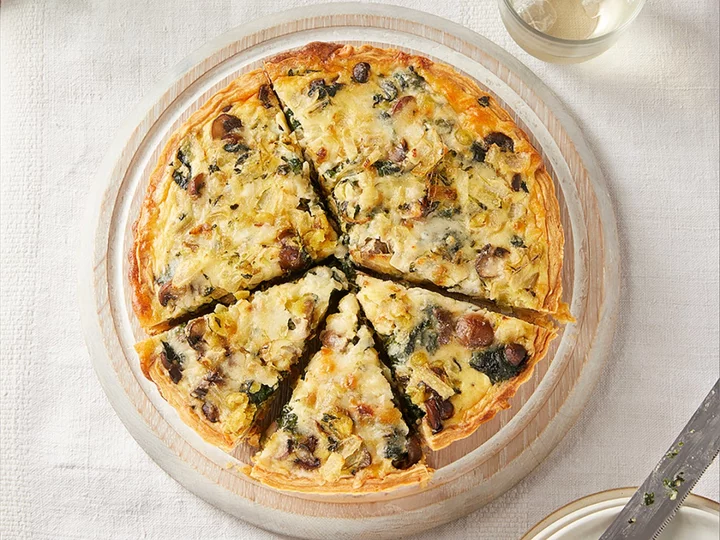
How to make spinach and mushroom quiche
It’s often said that quiche is old-fashioned, but there is nothing old-fashioned about this one,” says former Great British Bake Off contestant Hermine Dossou. “It’s a crumbly, super-short, melt-in-your-mouth pastry filled with buttery spinach and creamy custard. “Gruyère is the perfect cheese for quiche and a little goes a long way, but if it’s not available, you can substitute with Emmental, Comté, Jarlsberg or Beaufort.” Spinach and mushroom quiche Serves: 8 Ingredients: For the shortcrust pastry: 210g plain flour (gf plus 1 tsp xanthan gum), plus extra for dusting 130g cold butter 1 large egg (55g) 1 tbsp cold water ¼ tsp salt For the custard: 15g butterLeaves from 3 thyme sprigs 1 small yellow onion (about 50g), finely chopped 2 eggs 120g double cream 1 chicken or vegetable stock cube, crumbled 1 tsp Dijon mustard ¼ tsp salt Pinch of black pepper For the filling: 30g butter 250g mushrooms, sliced ½ tsp garlic powder A pinch of salt 250g baby spinach leaves 80g grated Gruyére cheese Method: 1. To make the shortcrust pastry, in a large bowl rub the flour and butter together with your fingertips until sandy in texture. (You can use a food processor to speed up this process.) Add the egg, water and salt and bring together into a dough without overworking it. Wrap in cling film and chill in the fridge – you always want to work with cold pastry as it’s much easier to handle. 2. When ready, lightly flour a work surface and roll out the dough to a circle about 30cm in diameter and 3mm thick. Use your rolling pin to lift it up and lay it over a 23cm tart tin, so there is an overhang of pastry at the top. Using a straight-sided glass, ease the pastry into the corners of the tin by rolling the glass around the edge in circular motion. Chill for 20 minutes. 3. Preheat your oven at 200C/180C fan/400F/Gas 6. Line your chilled pastry case with parchment paper, fill it with baking beans or cheap pulses, and blind bake for 15 minutes. Lift out the baking beans and parchment paper and continue baking for a further 10 minutes to dry out the base. 4. Meanwhile, make the custard. Put the butter, thyme and onion in a small frying pan over medium heat and cook until the onion is soft and transparent. Set aside to cool slightly. In a medium bowl, whisk together the eggs, cream, stock cube, mustard, salt and pepper, adding the cooked onions. Set aside. 5. Prepare the filling using the same pan you used to cook the onions. Heat the butter, add the mushrooms, garlic and salt, and cook over a high heat until the mushrooms are soft and most of the water has evaporated. Add the spinach and cook until it has wilted and the mixture is thick. 6. Tip the spinach mixture into the pre-baked tart case and spread it around evenly. Sprinkle over the grated cheese, then pour in the custard, making sure it’s distributed evenly. Bake at 200C/180C fan/400F/Gas 6 for 20–25 minutes, or until the middle of the quiche looks set and the top is slightly golden. Enjoy warm. ‘The Thrifty Baker’ by Hermine Dossou (White Lion, £18.99).
2023-09-06 13:52
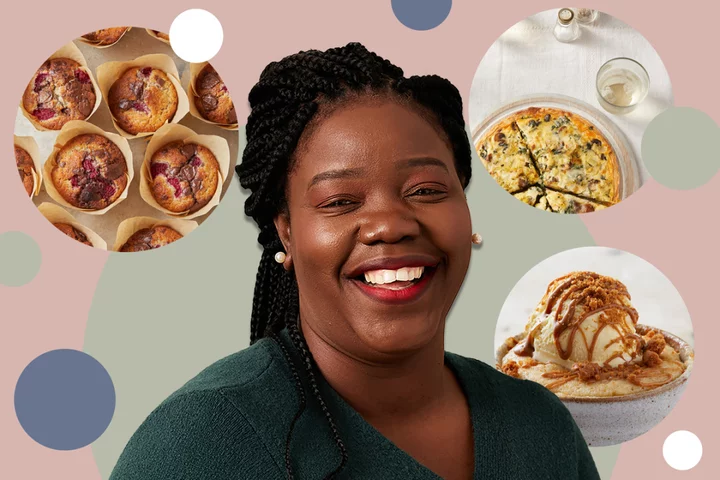
Hermine Dossou: Being thrifty in the kitchen helped me get on the housing ladder
As a trained accountant and a long-time baking enthusiast, Hermine Dossou knows a thing or two about saving money in the kitchen. “My first breadmaker was from Panasonic – I bought it from Gumtree,” the former Great British Bake Off contestant says. “It was basically somebody’s wedding present that they didn’t want and they sold it half price.” A devotee of Martin Lewis’s Money Saving Expert website, the 42-year-old, who was born in Benin, West Africa, and moved to the UK for university aged 20, tries to avoid ever paying full price for a big ticket item. “If I wanted to buy, let’s say, a mixer, I would go online, and type ‘Kenwood discount vouchers’ and then something always comes up,” says Dossou, who lives in Kettering and came fourth on the 2020 series of Bake Off. But the mum-of-one – whose son Steven is 13 – wasn’t always such a frugal foodie. “That came from that period where I became a single mum on a reduced income,” she says. “I couldn’t work full-time because I had to look after my son, and also I didn’t want him to have the processed kind of bakes.” Whipping up cakes and cookies filled her “empty afternoons” as a new mum and was a lot cheaper than buying ready-made baked goods. “I would cook from scratch and prep my vegetables when I could get them on offer,” she continues. “Same for fruits – they are often very discounted when they become a bit soft, and that’s the best time to make jam.” Even post-Bake Off and her book deal (she works full-time as an accountant), Dossou remains a savvy shopper, knowing that a higher price doesn’t always mean a better product. “Like a bar of chocolate, if it’s the same quantity of cocoa, why are you paying three times the price? Especially if you’re going to bake with it. “Wonky onions at half the price is the same… they all come from the same farm.” Her accountancy skills came in handy, too, and she still uses a spreadsheet to track her income and outgoings every month. “I think generally in life it is important to budget and know where your money goes, because I think it allows you to achieve a lot more than if you were just living freestyle,” Dossou says. “It’s a nightmare trying to get on the housing ladder here in the UK – that’s something I’ve been able to do through being thrifty in every area of my life.” That’s why she decided to call her first cookbook The Thrifty Baker: “I just really wanted to bring that awareness of how we choose what we eat, and how we can save through making little changes here and there.” “Now, more than ever, when people are struggling with the cost of living, I think it’s even more important to go back to those values of cooking from scratch, trying to cook at home, and making meals from, you know, not much.” With lots of advice for beginners, the book focuses on affordable dishes, from basic breads and simple biscuits to special occasion puds and impressive-looking desserts. There’s a distinct Gallic influence (Benin, where Dossou learned to bake as a child, is a former French colony) felt with recipes such as pain de campagne, orange and brown butter madeleinesm and pear frangipane tart. The author points out when a recipe can be cooked in an air fryer – a recent Black Friday bargain she loves because it allows her to enjoy fried Benin delicacies using less oil and without turning on the oven. “Because we have a really small family, just me and my son, you don’t always want to put the oven on just to bake something for two. “With an oven you’ll need to preheat it for a good 15 to 20 minutes before you can even bake in it. With the air fryer you just put the cake in and 15 minutes later it’s out – easy and convenient.” There’s also a section devoted to microwaveable mug cakes, with peanut butter and jam, speculoos (aka Biscoff) and chocolate hazelnut flavours of the cheap and easy-to-make single-serve puds. “In the microwave you can make a cake in five minutes from weighing, mixing and baking,” says Dossou, who loves how kid-friendly they are. “With my son I feel more inclined to let him make a mug cake than maybe something bigger. “Even if it goes wrong he’s not wasting a lot of ingredients and, you know, he’s not turning the kitchen into a bonfire.” ‘The Thrifty Baker’ by Hermine Dossou (White Lion, £18.99).
2023-09-06 13:45

FASHION PHOTOS: Naomi Campbell struts the runway in shimmery silver in new fast fashion collab
NEW YORK (AP) — Naomi Campbell was a vision in shiny metallic silver as she took the runway with her trademark supermodel swagger to display her collaboration with PrettyLittleThing, the fast fashion brand.
2023-09-06 13:29
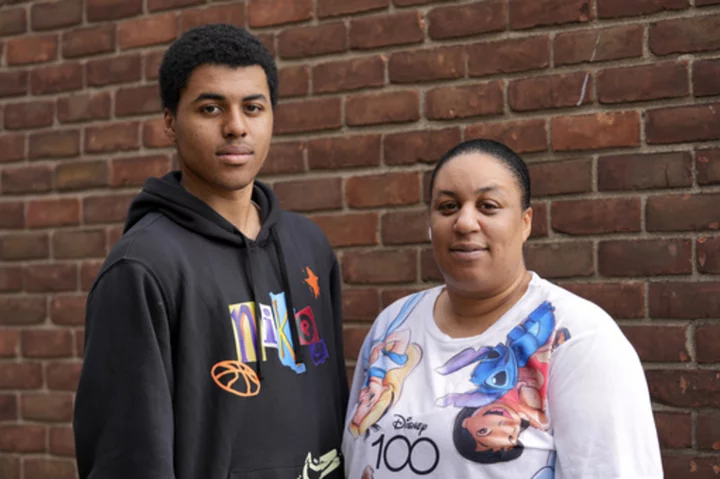
Schools are cutting advisers and tutors as COVID aid money dries up. Students are still struggling
An unprecedented infusion of aid money the U.S. government provided to schools during the pandemic has begun to dwindle
2023-09-06 12:26

Seal praises his and Heidi Klum’s daughter Leni for making him ‘a better person’ in rare post
Seal has spoken about his close relationship with his and his ex-wife Heidi Klum’s 19-year-old daughter, Leni Olum Klum. The musician, 60, took to Instagram on 4 September to share a snap of him and his daughter in New York City together. In the caption, he described how Leni has ultimately shaped his life, and pointed out how grateful he was for her. “In NY with the young woman who changed my life for the better 19yrs ago. Thank you Leni for making me a better person,” he wrote, before signing the tribute with: “Love you, - papa.” In the comments, Leni expressed her love for her father’s post, writing: “So cute! I love you papa,” along with a red heart emoji. Many fans of the singer went to the comments to praise his sweet relationship with Leni. “So much love in this photo! Have a wonderful time together!” one wrote, while another added: “Daddy and Daughter. Beautiful!!” The young model was born in May 2004, right after Klum split from Leni’s biological father, Italian businessman Flavio Briatore. In December 2009, Seal legally adopted Leni when she was five years old, while the singer and supermodel were still married. The former couple went on to have three more children: sons Henry, 17, and Johan, 16; and daughter Lou, 13. Klum filed for divorce in April 2012. This isn’t the first time that Seal has shown his support for the 19-year-old. During an interview with E! News in March, he spoke out about Leni’s career, as she has followed in her mother’s footsteps by becoming a model. While he noted that he’s “so proud of everything that Leni has done”, he’s “more proud of everything that she is”. “She walks through life with this type of humility that allows her to move so gracefully through it all and she has an innate understanding of people in general and people’s feelings,” the singer explained. “So I’m kind of more impressed with everything that she is.” Seal - whose real name is Seal Henry Olusegun Olumide Adeola Samuel - also spoke candidly about co-parenting with his ex-wife, adding: “I’d like to think, as a parent, that we have - between her mother and myself - that we’ve instilled some of that in her. But she can do no wrong in my eyes and she’s quite wonderful.” Earlier this year, Klum applauded her daughter for working on her mode;ling career while studying in college. “I’m very proud of my daughter and her modelling. And she’s studying at the same time, she’s juggling already,” the America’s Got Talent judge said during an interview with People in March. Meanwhile, Leni has also spoken out about working in the modelling industry as the child of two famous parents. During an interview with People in October 2022, she acknowledged that she “got a lift into” the modelling world due to her upbringing. “It’s just a fact. My parents are famous,” she said. However, when she was asked about the infamous “nepotism baby” label given to children of celebrities, Leni said it’s her own work ethic that has helped build her career thus far. “I did get help starting off, and I know that people would dream to start off with what I had,” the college student explained. “I’m so grateful that I’ve been able to take what was gifted to me by my mom. But I am doing the work and putting in the time. Now I’m working on my own, travelling alone, going to school. My mom and I just have the same love for the same thing.” Although she said that her own ambition has led her to success in her career, she still credited her parents for instilling a strong work ethic in her at a young age. “They have both taught me to be myself, and to do what makes me feel comfortable,” she said. “You can tell if you’re not comfortable and then the best of you isn’t brought out. I just think you should be open and honest with what makes you comfortable, be yourself, do what you love.” Read More Heidi Klum opens up about her and husband Tom Kaulitz’s 16-year age gap Heidi Klum’s model daughter Leni shows off grisly burn after admitting she ‘didn’t use enough sunscreen’ Heidi Klum gushes with pride over daughter Leni for ‘juggling’ modelling and college Heidi Klum denies she counts calories after report she eats 900 calories a day Sleeping pill could reduce levels of Alzheimer’s proteins Marathon runners on why autumn is the best time to start running
2023-09-06 05:57
